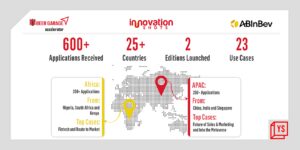Open banking is no longer a new concept in India, given its already critical role in galvanising the country’s banking industry over the past few years. Making definitive in-roads into the Industry 4.0 era, open banking is THE paradigm shift that empowers users with more control over their data and makes banking more convenient and inclusive than ever.
Even as India, a country where 179 bank accounts are opened every minute, prepares to hold its place among the largest domestic banking markets globally, open banking will play a pivotal role in powering its growth trajectory through financial inclusion and innovation at population scale.
“Banking has depended on legacy infrastructure for as long as we know. But as open banking offers glimpses of the nimble utility that consumers and businesses can avail, India is on the brink of a financial revolution. With higher fintech adoption by consumers encouraging innovation in financial services, collaborating with fintechs has now become ‘essential’ to this revolution, especially as consumers experiment with and adopt services beyond traditional banking,” shares Arvind Ronta, Head of Products, India & South Asia, Visa.
Boon or bane? Open Banking clears the air
Change is rarely comfortable, especially at the scale afforded by open banking. But as global market evolution illustrates, banks are better served by going with the trend than against it.
An Accenture study affirms this bold statement by outlining how banks that embrace open banking are likely to profit from a potential revenue uplift of 20 percent, while those failing to do so risk losing 30 percent to disruptive industry players. And as the ongoing pandemic continues to spew long-term uncertainty, being reactive or indecisive in this regard is hardly worth the risk.
Even though the open banking paradigm isn’t entirely new, the accelerated focus on digital solutions has helped democratise financial services. Collaborators, including fintech ventures, leverage APIs and data to create user-friendly solutions that foster financial inclusion and innovation.
So where is India on the world map of open banking?
While Europe may claim to be the ‘cradle of open banking’—and justifiably so—other countries are devising their own approaches to adopt open banking; each unique to their markets, services, and policy objectives. For instance, open banking development in the US and Japan has been driven by domestic markets, while countries such as Australia and the UK have adopted a regulatory-driven approach.
In contrast to global ways, India’s open banking ecosystem stands tall on a hybrid foundation; one where the market and government have collectively fueled the ecosystem’s development. And at the crux of this resides IndiaStack – a decade-old initiative, comprising several APIs, aimed at creating a unified software platform for governments, businesses, startups, and developers.
The country’s Unified Payment Interface (UPI) is one such subset of IndiaStack that has been pivotal in accelerating payment digitisation in India and gaining global recognition. On the private front, Sahamati—India’s only collective of Account Aggregator ecosystems—has been an integral catalyst in introducing open banking to the country. Another key component of IndiaStack is the Data Empowerment and Protection Architecture (DEPA), a novel consented data-sharing architecture to share data with traceability, auditability, ease, and safety.
With such robust innovations gaining pace, the future of India’s open banking ecosystem shines bright – especially in today’s rapidly digitising financial sector that goes beyond UPI. A mix of disruptive solutions also include open financing and e-KYC, which are critical to building an inter-operable and trustworthy fintech ecosystem, which can causally boost financial inclusion across different segments of the economy and the workforce.
Open credit: macro potential for the world’s largest microfinance market
Often remarked as ‘the next big disruption in lending’, Open Credit Enablement Network (OCEN) is about devising frameworks and protocols that can democratise credit for segments who need it the most.
Formal credit flow to the most vulnerable segments of our economy, especially small businesses, has resulted in severely underpenetrated credit delivery, with merely 11 percent of the 63 million MSMEs having access to formal credit.
OCEN reimagines the lending ecosystem as an ‘open network’ where the flow of credit is based on standardized protocols. This will allow multiple service providers – lenders, credit bureaus, underwriters, tech companies and a new type of entity called Loan Service Providers (LSPs)- to interface with customers and play the role of credit provider.
Banking services rely on advertent documentation and credit scores for credit issuance, which often becomes a roadblock for non-salaried individuals to access formal credit. This digitally transformative era, coupled with the rise of innovative fintech solutions, is making it easier to evaluate customers for credit eligibility across players. Visa is no stranger to OCEN or open banking. Given our contribution to this dynamic shift in lending, we have several partnerships that are already live, and more underway,” shares Arvind Ronta, elaborating on the agility and ease-of-utility of new, alternative lending platforms today.
India’s account aggregator framework decoded
If UPI transformed how people send money, Account Aggregators (AAs) have the potential to do that, and more, for all other types of financial transactions in India.
The AA is essentially the framework that provides a digital platform for easy sharing and consumption of data and information from financial information providers for the benefit of users. Very simply put, the AA is like Dunzo, except it deals with data. It picks up data for you and delivers it to a chosen destination.
An AA will facilitate the process of consent, much like how a UPI app facilitates the transfer of funds from one bank account to another. Importantly, AAs will be used to transfer financial data rather than funds.
AAs are, therefore, the biggest implementation of data sharing that can happen through OCEN. They will help lenders lend money to less individuals and small businesses in just minutes, not months.
Data-driven AAs: a thriving opportunity for fintech in India
Fundamentally – greater the data, greater the experience. The exponential value that data enjoys makes it an incredible asset. And when clubbed with the right algorithms, the combination promises to keep an accurate pulse-check on human behaviour, thus urging the sector to double-click on the idea of an open data economy. Easy sharing of verified data will truly digitise lending, making it much simpler for banks and businesses. Consequently, banks would be able to give credit faster and more securely, thus revolutionising the lending ecosystem and fostering financial inclusivity.
Allowing data to flow freely will lead to the growth of new players in fintech sub-sectors such as lending, wealth management, personal finance management, robo-advisory, and even accounting. Most importantly, it will usher in a new era of financial inclusion for the financially underserved, with India being the largest microfinance market in the world.
All this and more, spell interesting times for the financial services industry; not just in India, but across the world. Successful implementation and extension of the DEPA framework and AA architecture can set gold standards of protecting data, embed consent granting mechanisms into data transactions, and make data interoperability a reality, as India aims to become increasingly data democratic.
Visa’s tryst with open banking
To make open banking more conducive, Visa has invested heavily in developing data-driven solutions and extending them to the payments ecosystem through partnerships and cross-sector collaborations. To bring this to life, the company has made critical enhancements to their artificial intelligence and machine learning capabilities while retaining commensurate focus on securing their network and causally building trust within the ecosystem.
With such vast data repositories at stake, Visa also stresses on the need to establish ‘customer-first’ principles for data use and privacy when engaging with data, in order to empower customers through transparency and control through consent. The company also believes that frameworks and data standards should be open and interoperable; and that a cross-industry collaboration will maximize benefits of the data economy, and . Powered by these principles, Visa continues to engage with partners across the AA and OCEN space in India.



![Read more about the article [Funding alert] Language learning platform instrucko raises $1M in pre-Series A round](https://blog.digitalsevaa.com/wp-content/uploads/2021/07/Imagenbbh-1627029046683-300x150.jpg)






